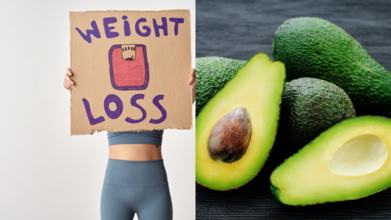- Health Conditions A-Z
- Health & Wellness
- Nutrition
- Fitness
- Health News
- Ayurveda
- Videos
- Medicine A-Z
- Parenting
Does How You Eat Avocado Affect Its Weight-Loss Benefits?

Credits: Canva
From sourdough toast to green smoothies, this creamy fruit has secured its spot as a global wellness icon. Packed with healthy fats, fibre, and enough Instagram clout to fill a mood board, it’s touted as a weight-loss-friendly superstar. But does the way you eat avocado really affect its slimming benefits, or is guac just guac no matter how you scoop it?
The Nutrient Profile That Makes Avocado Shine
One medium avocado carries around 240 calories, 21 grams of fat, and 10 grams of fibre. The fat is mostly monounsaturated (the heart-healthy kind that keeps you full), while the fibre slows digestion, stabilises blood sugar, and helps curb cravings. According to nutritionists, these factors make avocados weight-loss friendly. But how you prepare, pair, and portion this fruit can make or break its benefits.
Raw, Toasted, or Mashed: Does Form Matter?
Eating avocado raw is the cleanest way to enjoy its nutrients, like slices in a salad or scooped straight from the skin with a spoon. When you mash it into guacamole, you don’t lose nutrients, but the add-ins matter. A sprinkle of lime, tomato, and onion? Perfectly harmless. A mountain of salt and tortilla chips on the side? Suddenly, your “weight-loss snack” turns into a salt-and-carb bomb. Toasting avocado, meanwhile, doesn’t strip its healthy fats, but frying or cooking it in oil can double down on calories, leaving you with more fat than you bargained for.
The Avocado-Toast Trap
Avocado toast may look Instagram-worthy, but it’s a calorie load. Slathering half an avocado on sourdough bread topped with cheese, eggs, or smoked salmon can push a single “light” meal over 500 calories. Not exactly waist-friendly if you’re trying to keep a deficit. On the flip side, pairing avocado with a slice of wholegrain bread, a squeeze of lemon, and maybe a sprinkle of chilli flakes gives you fibre, healthy fats, and flavour without blowing your calorie budget. It’s not just what you eat, but what you eat it with.
Smoothies?
Avocado in smoothies is genius. It adds creaminess, fibre, and satiety and balances out the sugar hit from fruits like banana or mango. But blending avocado with nut butter, protein powder, honey, oats, and coconut milk. Suddenly your “green smoothie” becomes a 700-calorie dessert in disguise. To keep it waist-friendly, stick to half an avocado, a handful of spinach, unsweetened almond milk, and maybe some frozen berries. Smooth, satisfying, and slimming.
Portion Size
More isn’t always better. Because it’s calorie dense, eating an entire avocado daily can backfire. Nutritionists often recommend sticking to one-third or half an avocado per serving. That way you get all the fibre and fullness without tipping the calorie scales. Avocado is like olive oil, you wouldn’t drink it straight from the bottle, so why eat the whole fruit in one sitting?
Pairing Power
Pair avocado with protein, and you’ve got a hunger-busting combo. Slice it next to grilled chicken, eggs, or beans, and you’ll feel fuller for longer. Toss it into a salad with leafy greens, and its healthy fats help absorb fat-soluble vitamins like A, D, E, and K. But pair it with nachos, mayo, or bacon? That’s when your “weight-loss buddy” morphs into a high-calorie indulgence. The company avocado keeps is just as important as the avocado itself.
Avocado Isn’t Magic, But It’s Smart
How you eat avocado absolutely affects its weight-loss benefits. The fruit itself is nutrient-rich and slimming-friendly, but your preparation and pairings decide whether it supports your goals or sabotages them. Eat it raw, pair it with lean proteins or veggies, keep portions reasonable, and it’ll play the role of a weight-loss ally.
Top-Ranked Diets Of 2025 That Gained Widespread Popularity

Credits: Canva
Whether your goal is to care for your heart, manage your weight or follow a steadier eating routine, finding the right diet can play an important role in supporting your overall well-being. The food you choose becomes your body’s fuel, so getting the right mix of nutrients matters. With so many eating plans available today, it can be hard to know which ones stand out.
Listed below are the nine diets that earned the strongest average ratings. However, speak with your doctor before beginning any new eating plan.
Best Diets of 2025, According to Nutrition Experts
In 2025, several diets gained popularity and were the most searched on the internet:
Mediterranean Diet
The Mediterranean diet is rooted in plant foods such as vegetables, fruits, whole grains, legumes, nuts and olive oil, with moderate portions of fish, poultry, eggs and dairy. It recommends keeping red meat and processed foods to a minimum and is often viewed as a long-term lifestyle choice that includes regular activity and shared meals. This way of eating has been linked to many benefits, especially for heart health.
Research shows the MIND (Mediterranean-DASH Intervention for Neurodegenerative Delay) diet slows age-related cognitive decline. Other work suggests that the MIND diet supports better brain function even when typical age-related changes are present, hinting at its role in helping older adults stay mentally resilient. Lesli Bonci, Director of Sports Medicine Nutrition at the University of Pittsburgh Medical Center, points out that some of the foods highlighted in this plan may feel expensive for certain households, though she praises the diet for what it may offer the brain.
DASH Diet
The DASH (Dietary Approaches to Stop Hypertension) diet is an eating pattern created to help reduce blood pressure. It focuses on fruits, vegetables, whole grains, low-fat dairy, lean protein and nuts, while limiting items high in saturated fat, cholesterol and sodium. The plan advises keeping sodium to 2,300 mg per day, or 1,500 mg for a stricter reduction. It also includes potassium, magnesium and calcium, which play a role in blood pressure control.
The DASH diet was built with heart health as its main goal. Its low-sodium approach has been studied widely, and the findings show that the diet can lower blood pressure and reduce “bad” LDL cholesterol. Followers use a chart to estimate their calorie needs, which then guides their daily servings from each food group. Leslie Bonci, a registered dietitian, board-certified specialist in sports nutrition and member of the Forbes Health Advisory Board, notes that the plan is effective for managing blood pressure, though its focus on produce may make it costlier for some people.
Flexitarian Diet
A flexitarian diet is mostly vegetarian but leaves space for occasional servings of meat or fish. The term blends “flexible” and “vegetarian” and encourages plant foods such as fruits, vegetables, legumes and whole grains, with meat limited to a few times each week or less. It offers a relaxed structure and is often chosen for its possible health and environmental advantages, including weight control and lower risk of certain diseases.
For those who hope to follow a plant-led eating pattern without giving up all animal foods, the flexitarian diet can be a comfortable starting point. The International Food Information Council describes it as a “semi-vegetarian, plant-forward diet” that features fruits, vegetables, legumes, dairy and eggs, with smaller or less frequent servings of meat. Early research indicates that this style of eating may support weight control and reduce the risk of heart disease and diabetes.
Pescatarian Diet
A pescatarian diet follows a vegetarian base but includes fish and seafood while avoiding red meat and poultry. It centers on plant-based foods such as fruits, vegetables, grains and legumes, with seafood added for protein and omega-3 fats. Some pescatarians also choose to include eggs and dairy, depending on personal preference.
Another branch of vegetarian eating, the pescatarian diet earned high scores for its simplicity and safety. A 2020 study showed that pescatarians had lower rates of obesity and were less likely to have cardiovascular risk factors such as high BMI, high blood pressure and high cholesterol. “The eating plan is broad and allows for variety, but one must like fish!” says Lesli Bonci, as per Forbes.
MIND Diet
The MIND diet blends key parts of the Mediterranean and DASH approaches, with the goal of supporting long-term brain health and lowering the risk of conditions such as Alzheimer’s. It encourages regular intake of leafy greens, assorted vegetables, berries, nuts, whole grains, fish, poultry, and olive oil, while advising people to cut back on red meat, sugary foods, butter, cheese, and fried dishes. Its foundation rests on simple, plant-focused eating patterns linked with better protection against age-related cognitive decline.
Studies show that this eating pattern can slow the rate at which memory and thinking skills weaken over time. Research also suggests that people who follow the MIND diet often perform better on cognitive tests, even when age-related changes are present in the brain, which points to stronger resilience. Bonci adds that some of the recommended foods may be costly for certain households, though she supports the diet for its strong potential to aid brain health.
Orange Juice For Heart? A New Study Reveals Why It Is Great For Cardiovascular Health

Credits: iStock
If you like orange juice and drink it daily for your breakfast, you are good to go. But, if you are someone who does not drink orange juice, you may want to reconsider your food habits. Scientists found that that orange juice could actually extend your healthy life and benefit your cardiovascular health.
The study published in Wiley Online Library revealed that orange juice consumption could influence the activity of thousands of genes inside our immune cell. Many of these genes also control blood pressure, calm inflammation and manage the way the body processes sugar. All these functions play an important role for long-term heart health.
How Was The Study Conducted?
The study followed adults who drank 500ml of pure pasteurized orange juice everyday for two months. After a period of two months, many genes that leads to inflammation and higher blood pressure had become less active.
What Were These Genes? These included NAMPT, IL6, IL1B, and NLRP3. These genes switch on when the body is under stress. There is another gene called SGK1 that impacts kidneys ability to hold onto sodium or salt, which also became less active. These changes have also matched a previous findings that showed daily orange juice consumption could also reduce blood pressure. Orange juice contains hesperidin, a flavonoid that could help lower blood pressure. There are antioxidants too that are great for overall heart health.
What About The Blood Sugar Levels?
The trials have shown that orange juice does not simple raise blood sugar levels, instead, it triggers small shifts in the body's regulatory system that could reduce inflammation and also help blood vessels relax.
However, what is important to note is that hesperidin that influences the genes have varied response based on a person's body size. So, people who weigh more could show greater changes in gene, which also involves fat metabolism, while leaner people could show stronger effects on inflammation.
Orange And Heart Health
A systematic review from 2021, published in the journal Phytotherapy Research that involved 639 participants from 15 different studies also found that regular orange juice consumption lowered insulin resistance and blood cholesterol levels. Insulin resistance is what leads to diabetes, as it is the precursor for pre-diabetes, and high cholesterol is linked with heart diseases.
Another 2022 study published in journal Food & Function showed that overweight and obese adults noticed small reduction in systolic blood pressure and increase in high-density lipoprotein or HDL, which is also known as the 'good cholesterol'. This result was achieved only after several weeks of orange juice consumption. While these changes were modest, the improvements could make a greater difference, if the same food habits are maintained for years.
More answers come from looking at metabolites, the tiny molecules our bodies make while breaking down food. A recent review found that orange juice can influence several key pathways, including how we use energy, how our cells communicate, and how the body manages inflammation. It may even shape the gut microbiome, which experts now know plays a big role in heart health.
Furthermore, a 2023 study published in the journal Frontiers In Microbiology noted that people who drank blood orange juice daily for a month saw an increase in gut bacteria that produce short-chain fatty acids, compounds known to support healthy blood pressure and lower inflammation. These volunteers also showed better blood sugar control and reduced levels of inflammatory markers, hinting that the benefits of orange juice may go far beyond its refreshing taste.
Punjab Worst Hit By High Uranium Levels In India’s Groundwater; Raise Health Concerns

Credits: iStock
The latest Annual Ground Water Quality Report 2025 by the Central Ground Water Board (CGWB) has delivered a worrying revelation: Punjab now records the highest intensity of uranium contamination ever reported in India, with 62.5% of groundwater samples exceeding the safe limit post-monsoon. This is followed by Haryana, Delhi, Karnataka and Uttar Pradesh, indicating a dangerous pattern across north and north-central India.
While nitrate and fluoride remain more widespread contaminants, uranium’s increasing presence raises an urgent public health concern because even low-dose, long-term exposure can quietly harm vital organs.
Where Is Uranium Contamination Rising?
The CGWB tested 3,754 groundwater samples across India in pre- and post-monsoon seasons. The findings show a clear upward trend:
Nationally, uranium exceedance rose from 6.71% (pre-monsoon) to 7.91% (post-monsoon).
Punjab recorded the highest contamination:
- 53.04% pre-monsoon
- 62.50% post-monsoon
Haryana followed with 15–23.75% of samples above limits.
- Delhi: 13–15.66%
- Karnataka: 6–8%
- Uttar Pradesh: 5–6%
The report highlights northwestern India: Punjab, Haryana, Delhi, and parts of Rajasthan and Uttar Pradesh — as the main hotspot, likely due to geogenic factors, aquifer depletion, and intense groundwater extraction. Meanwhile, eastern and southern states reported minimal contamination.
Why Uranium in Water Is Dangerous
According to the 2025 study “Uranium’s hazardous effects on humans and recent developments in treatment,” the real threat from uranium lies in its chemical toxicity, not its radioactivity.
Kidney Damage: The Most Significant Risk
Uranium behaves like a heavy metal that gets absorbed and stored in the kidneys, impairing their ability to filter waste.
This can lead to:
- Proteinuria (excess protein in urine)
- Reduced kidney function
- Long-term kidney diseases
Even low-dose, chronic exposure through drinking water can gradually weaken renal functioning.
Respiratory Harm and Lung Cancer Risk
People who inhale uranium particles — especially workers in mining or processing — face:
- Chronic respiratory irritation
- Persistent coughing
- Higher risk of lung cancer, particularly due to radon gas produced as uranium decays
Gastrointestinal Entry and Toxic Build-Up
Recent findings note that the gastrointestinal system is the main route of uranium entry. Once consumed through contaminated water, uranium moves from the stomach and intestines into soft tissues and organs.
Bone Accumulation and Cancer Risk
Because uranium is a chemical analog of calcium, it can get deposited into bones. Over time, this raises the risk of bone cancer and may interfere with normal bone cell functioning.
Possible Reproductive and Developmental Effects
Animal studies suggest:
- Potential risks of congenital disabilities
- Effects on reproductive organs
- But direct evidence in humans remains incomplete, calling for more research.
Neurological and Immune Effects Being Explored
Some studies hint at:
- Behavioral changes
- Cognitive deficits
- Unclear impacts on the immune system
These areas remain under-studied but concerning.
Why India Must Worry Now
The CGWB report warns that while most groundwater in India remains safe, the pockets of rising uranium contamination require immediate monitoring and mitigation. With millions relying on groundwater for daily consumption, even a small rise in toxic metals can translate into widespread health damage over time.
Long-term exposure rarely shows immediate symptoms, which makes the threat quiet but deeply harmful.
© 2024 Bennett, Coleman & Company Limited

